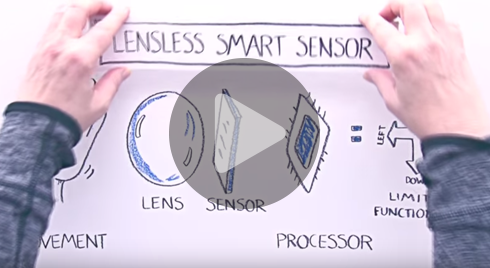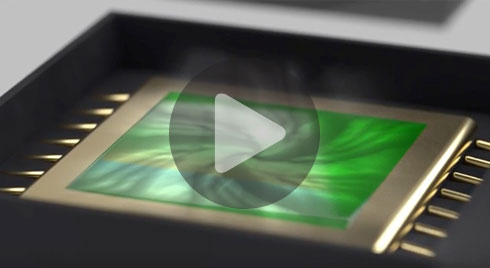Home > Emerging Solutions > Lensless Smart Sensors

Emerging Solutions
Lensless Smart Sensors
Low-power, low-cost visual sensing technology that captures information-rich scene data in a tiny form factor using a revolutionary new approach to optical sensing.

Enhanced Sensing
Collects information-rich sensing data in a wider FOV
Excellent at motion, optical flow, depth and change detection

Reduces Cost
Low-cost gratings combined with off-the-shelf image sensors provide the most cost-effective sensing versus competition
Enables new form factors and applications

Ultra-low Power
Superior point tracking abilities allows for less pixels, saving power
Gratings require no power for operation; reconstruct algorithms designed for best efficiency in battery-powered devices

Tiny Form Factor
Mass production modules an be ≤1mm thick
Enables deployment of sensing capabilities into the smallest of applications
Preserves Privacy
“Blob” data is unrecognizable to human eye – allows use of LSS in applications where focused images prsent a privacy risk
Lensless Smart Sensors
Simple-function, sensor-laden endpoints are expected to become ubiquitous as new layers of the IoT infrastructure go online. These environmentally-aware ‘lite’ endpoints will capture, analyze and transfer data to various devices and the cloud, but will have to do so in the most power- and size-optimized method possible. That is why Rambus scientists have pioneered Lensless Smart Sensor (LSS) technology for the new age of ubiquitous connectivity.

LSS enables the next-generation of low-power sensing through capturing information-rich images using a low-cost phase grating coupled with standard image sensors and sophisticated computational algorithms. Indeed, the spiral grating of LSS diffractive optics (hardware), coupled with sophisticated computational algorithms (software), reduce computation time while facilitating application-specific design flexibility. This allows computation to be effectively pushed past the ‘edge’ and performed on the LSS sensors themselves. LSS technology delivers a high-fidelity output for greater accuracy and more sophisticated capabilities in the areas of gesture recognition, depth and range tracking, point finding, and advanced object recognition.
As the number of potential applications for imaging and sensing continues to grow, LSS has been extended to operate in visible and thermal wavelengths, offering significant size and cost advantages versus standard thermal imaging modules. With the addition of these new capabilities, LSS can replace traditional thermal lenses with optical gratings that are significantly less expensive, enabling adoption of LSS thermal and visible sensing into a broad ranger of IoT applications including automotive, virtual and augmented reality, and smart home use cases.
As thin as 1 millimeter thick for a grating and a sensor, LSS technology is small enough to integrate directly into existing devices and applications to enable accurate sensing capabilities that are virtually invisible to the end user. Applications such as digital eyewear and smart home sensing can greatly benefit from its tiny size, by embedding LSS into the frames of digital eyewear for eye tracking or the faceplate screw of an electrical outlet for occupancy sensing and motion detection.
For more information about our Lensless Smart Sensor, please see our FAQ here.

Ensuring Privacy in Next Generation Room Occupancy Sensing
The long-awaited promise of smart homes and buildings adapting to occupant preferences and requirements is slowly becoming a reality. Traditional sensing technology is still somewhat limited in this context, with sensors primarily designed to detect motion rather than occupancy. Fortunately, new smart sensor technology offers the promise of true occupancy detection, along with an improved understanding of space utilization and occupant traffic patterns.
LSS for Smart Buildings
Smart buildings and homes are moving beyond traditional structures to become complex, connected systems designed to optimize efficiency, productivity, comfort and safety of the building and its occupants. With its tiny form factor, low power, low cost and wide field of view, LSS is an ideal sensing solution for building automation systems and can be easily integrated into smart LED bulbs, commercial light fixtures, or an unobtrusive discrete sensor pack.

LSS is able to detect and interpret activity within a space at a size and performance previously unattainable with existing building sensing technologies, all without compromising privacy. The data about the general activity and number of occupants in the area can be used to intelligently trigger environmental systems, monitor traffic flows and optimize area usage, reducing the environmental impact, and operating and maintenance costs.
LSS POD 2.0 Evaluation Kit
In an effort to accelerate adoption and amplify the discovery of new use cases and applications, Rambus has launched the POD 2.0 hardware and software development kit. The POD 2.0 customer evaluation system is designed for an easy out-of-the-box experience, enabling our customers and partners to quickly evaluate the performance of LSS and develop custom algorithms for their specific applications.
The kits include evaluation boards with an LSS module and USB 3.0 interface, mounting hardware, control software, documentation and cabling. A software development kit (SDK) with reference algorithm libraries is also available.
Evaluation kits are currently shipping to select OEMs and ecosystem partners – please contact us for availability and download the LSS Evaluation Kit brief for more information.
LSS for Augmented and Virtual Reality
As augmented and virtual reality becomes a part of our work and personal lives, OEMs will quickly need to add eye tracking hardware solutions into their products. With eye tracking, the user’s eyes become the input device, enabling advanced UIs, optimized video rendering, and other performance and user experience features. LSS is an ideal hardware method of tracking the eye’s gaze for augmented reality applications with its tiny form factor, low power, and wide field of view.




